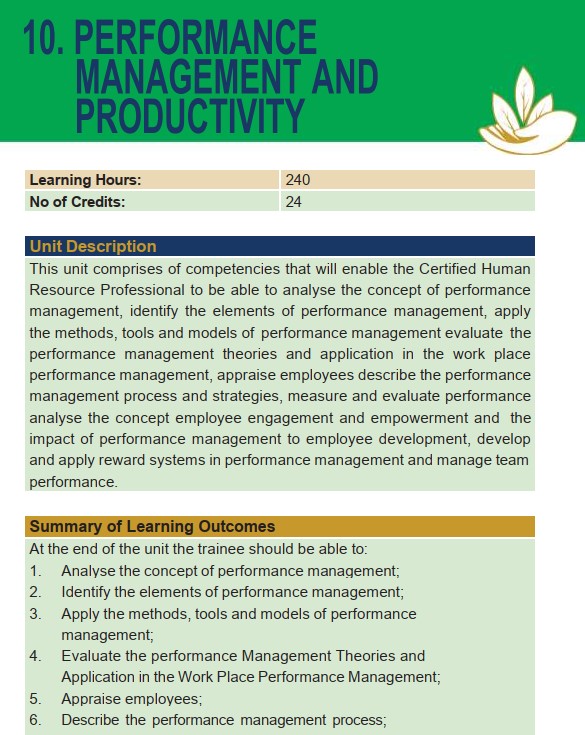
Topics
1. Introduction to Performance Management
1.1 Definitions of performance management
1.2 Aims and objectives of performance management
1.3 History of performance management
1.4 Steps of performance management
1.5 Principles of performance management
1.6 Factors of performance management
1.7 Performance management characteristics
1.8 Performance management scope
1.9 Benefits and challenges of performance management
1.10 Overcoming the challenges of performance management
2. Elements of Performance Management
2.1 Inputs and outputs
2.2 Outcomes
2.3 Process
2.4 Planning
2.5 Measures
2.6 Continual improvement
2.7 Continual competencies development
2.8 Communication
2.9 Stakeholder recognition and engagement
2.10 Equity and fairness
3. Methods, Tools and Models of Performance Management
3.1 Graphic rating scales
3.2 Management by objectives
3.3 Management by walking around
3.4 Forced ranking
3.5 Performance appraisals
3.6 Productivity tests
3.7 360 degrees’ feedback
3.8 Balanced score card
3.9 Performance pyramid
3.10 Fitzgerald and Moon’s building block model
3.11 Performance prism
3.12 Determining performance measures
3.13 Linkage between performance management and organisation competitiveness
3.14 Performance measures
4. Performance Management Theories and Application In the Work Place Performance Management
4.1 Introduction to theories and approaches of performance management
4.2 Goal setting theory
4.3 Systems theory
4.4 Expectance theory
4.5 Duo-factor theory
4.6 The comparative approach
4.7 The attribute approach
4.8 The behavioral approach
4.9 The quality approach
4.10 Results approach
4.11 Merits and demerits of the different approaches
5. Performance Appraisal
5.1. Introduction to performance appraisal
5.2. Differentiating performance appraisal, review and performance assessment
5.3. Objectives of performance appraisal
5.4. Appraisal methods
5.5. Appraisal forms
5.6. Appraisal responsibilities
5.7. Appraisal interviews
5.8. Performance feedback
5.9. Benefits and challenges in performance appraisal
5.10. Overcoming the challenges
6. Performance Management Process
6.1. Introduction to performance management process
6.2. The planning phase
6.3. Assignment phase
6.4. Execution phase
6.5. Assessment phase
6.6. Reviewing phase
6.7. Performance contracting renewal
7. Performance Management Strategies
7.1. Setting performance goals and targets
7.2. Establishment of key performance indicators
7.3. Determining performance measures
7.4. Delegation
7.5. Coaching
7.6. Mentoring
7.7. Performance gap analysis and feedback
7.8. Performance review meetings
7.9. Training and development
7.10. Recognition and reward
8. Performance Measurement and Evaluation
8.1. Introduction to performance measurement and evaluation
8.2. Objectives of performance measurement and evaluation
8.3. Principles of performance measurement and evaluation
8.4. Philosophy of measuring HR
8.5. Measurement framework
8.6. Categories of potential measures
8.7. Challenges in performance measurement and evaluation
9. Employee Engagement and Empowerment
9.1. Introduction to employee commitment, engagement and empowerment
9.2. Distinction between employee commitment and engagement
9.3. Objectives of employee engagement and empowerment
9.4. Principles of employee engagement and empowerment
9.5. Components of employee engagement and empowerment
9.6. Responsibilities in employee Engagement
9.7. Theories of employee engagement and empowerment
9.8. Engagement framework
9.9. Levels of employee empowerment
9.10 Process of employee empowerment
9.11 Benefits of employee engagement and empowerment
9.12 Engagement and empowerment Strategies
9.13 Enablers of employee engagement and empowerment
9.14 Impact of social media on employee engagement
9.15 Trends in employee engagement and empowerment
9.16 Measurement of employee engagement
10. Impact of Performance Management to Employee Development
10.1 Introduction to employee development
10.2 Objectives of employee development plans
10.3 The criteria of setting challenging goals in performance management
10.4 Employee development planning process
10.5 Elements of employee development plan
10.6 Professional development goals
10.7 Employee development strategies
10.8 Factors for successful implementation of development programs
11. Reward Systems in Performance Management
11.1 Traditional and contingent pay plans
11.2 Reasons for introducing contingent pay
11.3 Challenges of contingent pay
11.4 Types of contingent pay plans
11.5 Putting pay in context
11.6 Pay structures
11.7 Managerial incentive schemes
12. Managing Team Performance
12.1 Introduction to team performance
12.2 Types of work teams
12.3 Objectives of work teams
12.4 Team assignments
12.5 Managing team assignments
12.6 Equity in teamwork
12.7 Benefits and challenges of work teams
12.8 Techniques of measuring individual contributions in team assignments
12.9 Recognition and Teamwork Reward
13. Emerging Issues in Productivity & Performance & their ICT Applications
